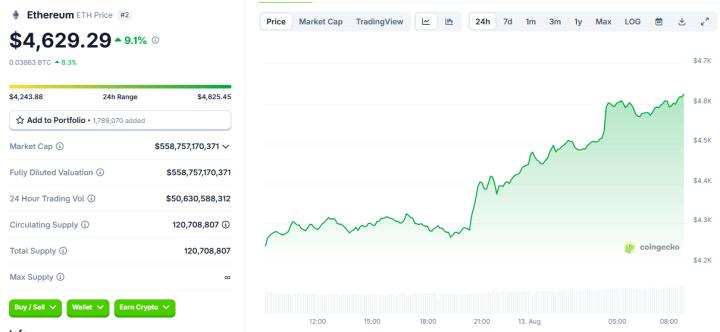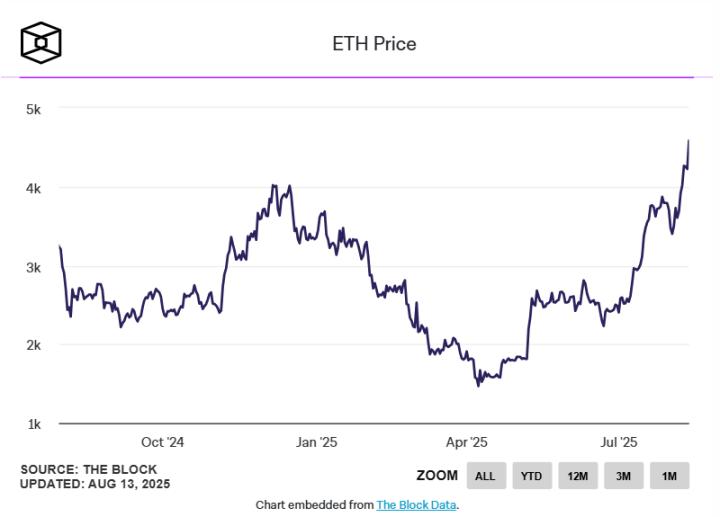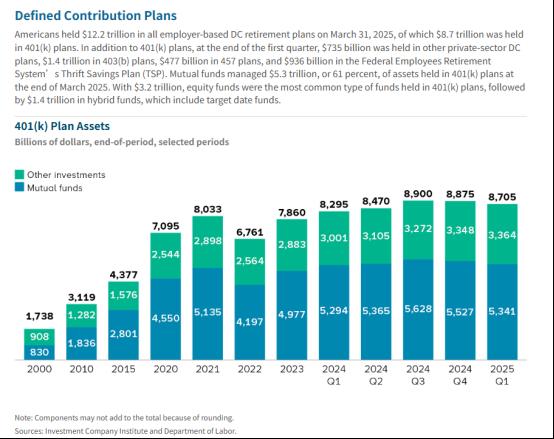Shaw, Jinse Finance
Bitcoin surged strongly in the early hours today, briefly breaking through $124,400 and creating a new high, surpassing the previous historical peak of $123,205.12 on July 14. The crypto market generally rose, with Ethereum continuing to strengthen, having already reached its highest level since November 2021.
Meanwhile, the Nasdaq and S&P 500 indices continued to create new closing highs. The "crypto newcomer" Bullish debuted with an initial surge of nearly 200%, which later significantly dropped to an 89% increase.
What are the driving factors behind this round of Bitcoin and crypto market rise, and how far can this trend go?
I. What Factors Drive This Market Rise
1. Federal Reserve Rate Cut Expectations Boost Bitcoin and Risk Assets
The latest US CPI inflation data met expectations, strengthening market bets on a September Fed rate cut. US Treasury Secretary Becent stated in an interview that the Fed's rates should be 150-175 basis points lower, and the Fed could have cut rates earlier if the data was accurate. Becent believes the Fed might cut rates by 50 basis points, potentially starting with a 50 basis point cut in September. Trump continues to pressure the Fed, suggesting rates should be lowered to 1%. Additionally, Goldman Sachs' macroeconomic research predicts the Fed will cut rates by 25 basis points in September, October, and December this year, with two more 25 basis point cuts in 2026, targeting a terminal rate range of 3-3.25%.
The deepening Fed rate cut expectations significantly stimulated the rise of risk-preference assets like Bitcoin. As the Fed cuts rates, US Treasury yields will decline, potentially driving more investors to seek higher-yield alternative assets. This capital inflow trend to non-traditional investment categories like cryptocurrencies may further support Bitcoin's potential price increase.
2. "Crypto-Stock Convergence" Drives Crypto Market Continuous Rise
The crypto market's parallel rise with US stocks reflects the global market's continued risk appetite. Analysts say this highlights the deep linkage between cryptocurrencies and stock markets, driven by Trump's friendly policy environment and significant institutional fund entry. The high correlation between cryptocurrencies and traditional stock markets is a notable feature of this rise. Speculative market sectors and mainstream benchmark indices draw power from the same optimistic sentiment source, reflecting the current market's overall risk appetite enhancement. This linkage effect indicates that digital assets are gradually integrating into traditional financial market risk pricing systems, with institutional investors viewing cryptocurrencies as an important portfolio risk asset component.
Moreover, the recent concentrated outbreak of multiple "crypto" hot stocks has somewhat stimulated the crypto market's strength. On August 13, digital asset trading platform Bullish listed on the NYSE, with its stock price doubling intraday, becoming another hot "crypto" stock this year after the "stablecoin first stock" Circle. Due to significant volatility, the stock was temporarily suspended multiple times, closing at $68, up nearly 84% for the day, with a market value approaching $10 billion. To prevent excessive price fluctuation, Bullish allocated about 20% of its issuance to individual investors, higher than the usual less than 10%. The company received $200 million in subscription intentions from renowned institutions like BlackRock and ARK Invest before issuance, demonstrating Wall Street's strong interest in crypto trading platforms.
Circle also released its 2025 fiscal second-quarter financial report on Tuesday. The report shows that USDC circulation grew 90% year-on-year to $6.13 billion by the end of the second quarter, with total and reserve revenues increasing 53% year-on-year to $658 million. The quarter's net loss was $482 million, mainly due to two non-cash expenses related to the initial public offering (IPO).
3. Corporate Bitcoin Hoarding Trend Intensifies, Institutional Funds Enter Massively
Listed companies establishing crypto asset reserves has become a trend. Led by Michael Saylor's MicroStrategy, more companies are adopting Bitcoin hoarding strategies, significantly boosting market demand. This practice has recently expanded to cryptocurrencies like Ethereum, driving the entire digital asset sector's rise. Bitcoin treasury reserve companies are represented by MicroStrategy and Metaplanet. Data shows that the top five Bitcoin reserve entities hold 772,359 BTC. The top 100 entities hold a total of 951,323 BTC. Various institutions now hold 3.64 million BTC, mostly through ETFs and funds.
Additionally, TraderT monitoring data shows US spot Bitcoin ETFs net inflows of $6 billion in July. Since August 6, US spot Bitcoin ETFs have seen consecutive weekly net inflows totaling $557.53 million. Massive fund inflows into Bitcoin spot ETFs continue to drive Bitcoin's price higher.
Unlike previous retail-driven bull markets, this Bitcoin bull market shows clear institutional characteristics. Continuous ETF inflows provide stable funding support for Bitcoin, maintaining a relatively smooth ascent even when facing technical resistance. Standard Chartered Bank analysis notes that in Bitcoin, corporate balance sheet allocation influences market perception and liquidity.
4. Crypto-Friendly Regulatory Policies Drive Market Upward
Recent US crypto-friendly regulatory policies have also driven Bitcoin and the overall crypto market's strength. Last Thursday, Trump issued an executive order promoting alternative asset investments in 401(k) retirement plans, including private equity and crypto assets. Currently, 401(k) plans manage $9 trillion in assets, with over 90 million Americans using the plan. Previously, the plan mainly invested in low-risk assets like Treasury bonds and mutual funds. Market estimates suggest that if 401(k) plans allocate just 2% to cryptocurrencies, it would mean $170 billion in new fund inflows—equivalent to two-thirds of existing crypto spot ETF and listed reserve market value.
Moreover, the US Treasury recently auctioned $100 billion in four-week Treasury bills, a historical high. The Fiscal Borrowing Advisory Committee noted that recent stablecoin issuance volume is a new emerging demand source. Under Trump's GENIUS Act, stablecoin issuers must use Treasury bonds and other safe assets to support their crypto tokens, indirectly boosting Treasury demand. Since the GENIUS Act's introduction, stablecoin market circulation has continuously increased. The stablecoin market experienced a $9.11 billion market value surge in 23 days. According to defillama.com and artemisanalytics.com data, the total stablecoin market value has exceeded $270 billion. The significant increase in stablecoin issuance and circulation has become an important buying support for Bitcoin's strong rise.
II. What's Next for Bitcoin and Crypto Markets?
With this bull market continuously heating up, what will Bitcoin's future trajectory be, and can the crypto market continue to exert force? Let's look at market perspectives and analyses.
1. IG Market Analyst Tony Sycamore stated that Bitcoin's momentum comes from increased certainty of Fed rate cuts, continuous institutional buying, and Trump administration's measures to relax crypto asset investments. He wrote in a statement: "Technically, if Bitcoin effectively breaks through $125,000, it could drive it to $150,000."
2. DYOR Crypto Research Platform CEO Ben Kurland stated: "Slowing inflation, enhanced rate cut expectations, and unprecedented institutional participation through ETFs have collectively created strong momentum. What's different this time is a more mature demand foundation - this rally is not just retail frenzy, but also structural buying from asset management companies, corporations, and sovereign funds." 3. Real Vision Chief Crypto Analyst Jamie Coutts estimates that with U.S. federal debt reaching a record $37 trillion, growing money supply, and increasing inflation concerns, people may recognize Bitcoin's monetary scarcity, potentially pushing Bitcoin's price above $132,000 by the end of 2025. 4. CryptoQuant Analyst Axel Adler Jr released a chart showing that despite BTC reaching an all-time high (ATH), the actual profit and loss ratio remains near the average level. In this context, the risk of a significant trend reversal is significantly reduced compared to periods when the profit and loss ratio was at its peak and the market was overheated. 5. Crypto Analysis Company Swissblock stated, "We always hear people say: 'False breakout, selling.' The fact is completely different. Since the April low, this rally has been driven by spot trading - large fund allocators are frantically buying almost all remaining BTC. The futures to spot ratio has fallen to October 2022 lows, signaling epic spot demand. This is true." 6. CryptoQuant Analyst Axel Adler Jr analyzed that the issue in the late bull market is declining investor risk appetite. Data shows the indicator broke through 1.9 in March and December 2024, but is now forming lower peaks, with holders actively selling and putting pressure on the market. Although investors are still taking profits, each new price increase brings marginally smaller cost basis premiums. The analyst suggests that considering the Fed's expected two rate cuts this year, two more increases are anticipated in this cycle, after which selling pressure will exceed demand, and the market will enter a correction phase. 6. Ethereum Co-founder and ConsenSys CEO Joe Lubin stated that Treasury companies might push ETH market cap beyond BTC within a year. 7. CryptoQuant Analyst CryptoOnchain said, "Outlook: Market volatility will intensify, but bull market structure remains intact. Short-term: High leverage, resistance levels, and increased exchange fund inflows raise the risk of sharp downward fluctuations. Medium-term: Strong institutional fund inflows, ETF demand, and network upgrades should contain severe market pullbacks and maintain a broader upward trend."






